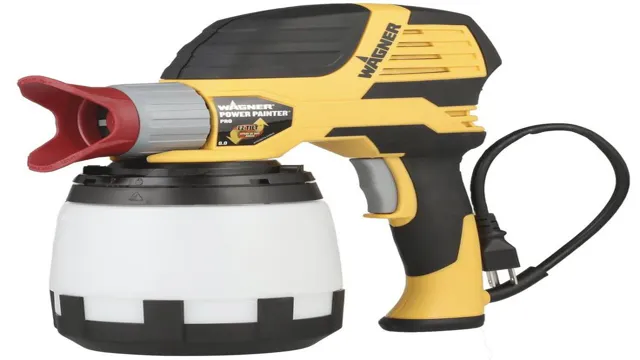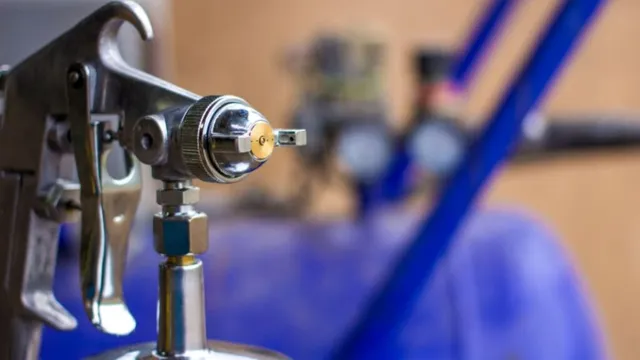Can You Use a Paint Sprayer Indoors? Tips for Safe and Efficient Spray Painting Inside

Painting is a popular pastime for many people, whether it’s for DIY projects or professional work. However, using a paint sprayer indoors can be tricky business. With the risk of potentially damaging your surroundings, you might be wondering whether it’s even possible to use this tool for indoor painting.
Well, the good news is that it is possible, and with some tips and tricks, you can make it work. In this blog, we will guide you through the dos and don’ts of using a paint sprayer indoors, as well as the best practices for achieving great results while keeping your home and health safe. So, let’s get started!
What is a paint sprayer?
Paint sprayers are tools used to apply a thin, even coat of paint to a surface quickly and efficiently. They work by spraying high-pressure air or gas through a nozzle, which disperses the paint in tiny droplets, creating an even and uniform finish. While they can be a very effective tool for painting, many people wonder if they can use a paint sprayer indoors.
The short answer is yes, you can use a paint sprayer indoors, but there are some precautions you should take to ensure your safety. Firstly, you should ensure proper ventilation in the room. This means opening windows and doors to allow for fresh air circulation.
Additionally, you should wear protective gear, such as a mask, goggles, and a hat, to shield yourself from any potential paint splatters. Finally, be sure to cover any nearby furniture or objects with plastic sheeting or drop cloths to protect them from overspray. By taking these precautions, you can safely and effectively use a paint sprayer indoors to achieve professional-looking results.
Definition and Types
A paint sprayer is a tool used in painting to spray paint or coatings on various surfaces evenly. Unlike traditional painting tools such as brushes or rollers, a paint sprayer uses a compressed air system, piston, or turbine to atomize the paint into tiny droplets, which are then sprayed onto the surface. The result is a smooth, even finish that covers the surface quickly and with less effort than traditional methods.
There are three main types of paint sprayers: airless, HVLP, and LVLP. Airless sprayers use high pressure to spray paint without the need for compressed air, while HVLP and LVLP sprayers use low pressure and are more suitable for finishing work. HVLP sprayers produce a high transfer rate of paint, meaning more paint ends up on the surface being painted, while LVLP sprayers use less pressure and less paint but are more efficient.
Whatever the type of paint sprayer, they all offer a faster, more efficient and professional-looking result than traditional painting tools.

Can you use a paint sprayer indoors?
Yes, you can use a paint sprayer indoors, but there are certain precautions you need to take. Firstly, it’s important that you have good ventilation in the area you plan on painting in. This means opening windows, using fans and ideally wearing a mask to avoid inhaling any fumes.
Secondly, you need to prepare the surfaces you’ll be painting very thoroughly to avoid overspray. This includes covering floors and any surrounding objects with plastic or drop cloths, as well as taping off any areas you don’t want to be painted. It’s also important to keep in mind that paint sprayers can be quite loud, so it’s best to use them during the daytime when it won’t disturb anyone.
In summary, using a paint sprayer indoors can be a great option to achieve a professional, smooth finish on your walls or furniture, just make sure to take the necessary precautions to keep everyone safe.
Yes, but with caution
If you’re thinking of using a paint sprayer indoors, the short answer is yes, but with caution. There are a few important things to consider before you start spraying away. First, make sure you have proper ventilation.
A paint sprayer can create a lot of dust and fumes, which can be harmful if inhaled. So, open windows and doors, and use a fan to circulate the air. Second, protect yourself and your surroundings.
Wear a respirator mask, goggles, and gloves to protect your skin and eyes. Cover the floor and any furniture or fixtures you don’t want to get paint on with plastic sheeting. Finally, read and follow the manufacturer’s instructions carefully.
Different paint sprayers have different settings and requirements, so it’s important to know exactly how to use your specific sprayer. By taking these precautions, you can safely and effectively use a paint sprayer indoors and achieve professional-looking results.
Benefits of using a paint sprayer indoors
Yes, you can use a paint sprayer indoors. In fact, using a paint sprayer indoors has numerous benefits. First and foremost, it saves a significant amount of time compared to traditional methods like brushing or rolling.
With a paint sprayer, you can cover large areas in no time, and you don’t have to spend hours cleaning brushes and rollers. Additionally, a paint sprayer provides a smooth, even finish that is difficult to achieve with traditional methods. It ensures that every inch of the wall or surface is evenly coated, leaving no brush marks or streaks.
Another benefit of using a paint sprayer indoors is that it reduces the amount of overspray and mess. As long as you take proper precautions like masking and covering nearby furniture and surfaces, you can easily control the amount of overspray and keep the surrounding areas clean. Overall, using a paint sprayer indoors is a great way to save time, get a flawless finish, and reduce mess and cleanup time.
Saves time and energy
As someone who has spent countless hours painting walls and ceilings with a brush or roller, I can attest to the time and energy that it takes to get the job done. That’s why I highly recommend using a paint sprayer indoors. Not only does it produce a smoother and more consistent finish, but it also saves you a significant amount of time and energy.
With a paint sprayer, you can cover large areas quickly and efficiently, without the need for multiple coats. Plus, you won’t have to worry about those pesky brush strokes or roller marks that can ruin the look of your paint job. Overall, using a paint sprayer indoors is a smart and convenient choice, especially if you want a professional-looking finish in a fraction of the time and effort.
So, if you’re planning on painting your living room, bedroom, or any other indoor space, don’t hesitate to invest in a quality paint sprayer. It will make your life so much easier!
Conclusion
In conclusion, the question of whether or not you can use a paint sprayer indoors is a nuanced one. While it is technically possible to use a paint sprayer indoors, there are a number of factors to consider, such as ventilation and the type of paint being used. So, before you take the plunge and start spraying away in your living room, make sure you weigh the pros and cons carefully.
After all, you don’t want to end up with a bold new paint job and a splitting headache to match!”
FAQs
Is it safe to use a paint sprayer indoors?
Yes, but proper precautions need to be taken such as wearing a mask and ensuring proper ventilation.
What type of paint sprayer should I use indoors?
An airless paint sprayer or a high-volume, low-pressure (HVLP) sprayer is recommended for indoor use.
Do I need to cover everything in the room when using a paint sprayer indoors?
Yes, it is recommended to cover all furniture, floors, and surfaces with plastic or drop cloths to avoid damaging them.
Can I use a paint sprayer indoors without any ventilation?
No, it is important to have proper ventilation such as opening windows, using a fan, or using an air filtration system.
How do I clean my paint sprayer after using it indoors?
Follow the manufacturer’s instructions for cleaning and use a cleaning solution specifically designed for your paint sprayer.
What type of paint can I use in my indoor paint sprayer?
Any paint can be used as long as it is compatible with the type of sprayer you have and meets indoor air quality regulations.
Can I use a paint sprayer to paint textured surfaces indoors?
Yes, but it is important to choose a paint sprayer that is designed for textured surfaces and to follow the manufacturer’s instructions for use.



